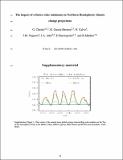Por favor, use este identificador para citar o enlazar a este item:
http://hdl.handle.net/10261/131341COMPARTIR / EXPORTAR:
 SHARE SHARE
 CORE
BASE CORE
BASE
|
|
| Visualizar otros formatos: MARC | Dublin Core | RDF | ORE | MODS | METS | DIDL | DATACITE | |

| Título: | The impact of a future solar minimum on climate change projections in the Northern Hemisphere |
Autor: | Chiodo, G.; García Herrera, Ricardo CSIC ORCID; Calvo, N.; Vaquero, José Manuel; Añel, Juan A.; Barriopedro, David CSIC ORCID ; Matthes, Katja | Palabras clave: | Climate change projections Global models Future solar minimum |
Fecha de publicación: | 7-mar-2016 | Editor: | Institute of Physics Publishing | Citación: | Environmental Research Letters, 11 (3): 034015 (2016) | Resumen: | Solar variability represents a source of uncertainty in the future forcings used in climate model simulations. Current knowledge indicates that a descent of solar activity into an extended minimum state is a possible scenario. With aid of experiments from a state-of-the-art Earth system model,we investigate the impact of a future solar minimum on Northern Hemisphere climate change projections. This scenario is constructed from recent 11 year solar-cycle minima of the solar spectral irradiance, and is therefore more conservative than the 'grand' minima employed in some previous modeling studies. Despite the small reduction in total solar irradiance (0.36 W m−2), relatively large responses emerge in the winter Northern Hemisphere, with a reduction in regional-scale projected warming by up to 40%. To identify the origin of the enhanced regional signals, we assess the role of the different mechanisms by performing additional experiments forced only by irradiance changes at different wavelengths of the solar spectrum. We find that a reduction in visible irradiance drives changes in the stationary wave pattern of the North Pacific and sea–ice cover. A decrease in UV irradiance leads to smaller surface signals, although its regional effects are not negligible. These results point to a distinct but additive role of UV and visible irradiance in the Earth's climate, and stress the need to account for solar forcing as a source of uncertainty in regional scale projections. | Versión del editor: | http://dx.doi.org/10.1088/1748-9326/11/3/034015 | URI: | http://hdl.handle.net/10261/131341 | DOI: | 10.1088/1748-9326/11/3/034015 | E-ISSN: | 1748-9326 |
| Aparece en las colecciones: | (IGEO) Artículos |
Ficheros en este ítem:
| Fichero | Descripción | Tamaño | Formato | |
|---|---|---|---|---|
| ERL_2016_11_3_034015.pdf | 3,61 MB | Adobe PDF |  Visualizar/Abrir | |
| ERL_2016_11_3_034015_suppdata.pdf | Supplementary data | 2,5 MB | Adobe PDF |  Visualizar/Abrir |
CORE Recommender
SCOPUSTM
Citations
24
checked on 18-abr-2024
WEB OF SCIENCETM
Citations
22
checked on 24-feb-2024
Page view(s)
352
checked on 24-abr-2024
Download(s)
327
checked on 24-abr-2024
Google ScholarTM
Check
Altmetric
Altmetric
NOTA: Los ítems de Digital.CSIC están protegidos por copyright, con todos los derechos reservados, a menos que se indique lo contrario.
